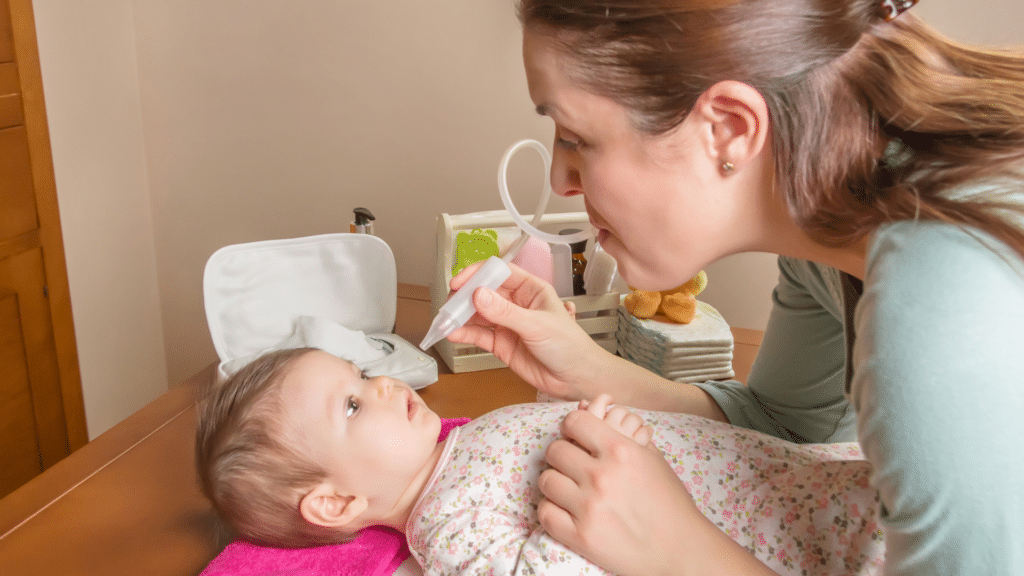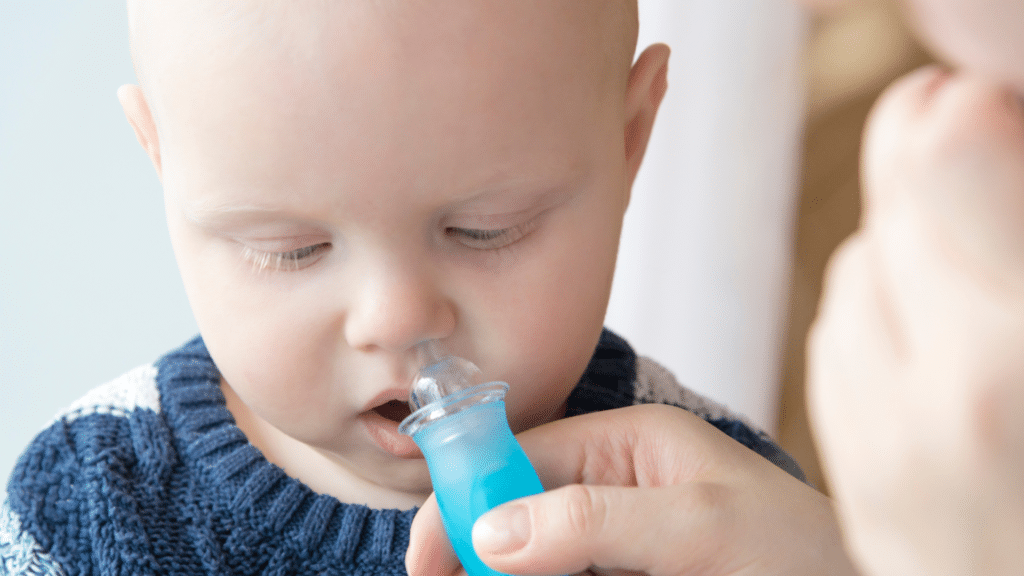Nasal irrigation is a simple and effective method for clearing a baby’s nasal passages of mucus, allergens, and other irritants. It involves using a saline solution to gently flush out the nasal passages, helping to relieve congestion, reduce allergy symptoms, and promote overall nasal health.
However, discussing and considering the safety aspect is crucial when performing nasal irrigation on babies. Babies have delicate nasal passages, and improper technique or forceful irrigation can potentially cause harm or discomfort.
This blog aims to provide an in-depth understanding of nasal irrigation for babies, its benefits, and, most importantly, the safety precautions that need to be taken to ensure a positive outcome for your little one.

Understanding Nasal Irrigation
Nasal irrigation, also known as nasal lavage or nasal rinse, is a procedure that involves flushing the nasal passages with a saline solution. The main purpose of nasal irrigation is to improve nasal hygiene and relieve symptoms of nasal congestion, allergies, colds, and sinus infections. It can be particularly helpful in loosening thick mucus and improving breathing for babies.
Different Methods of Nasal Irrigation for Babies
Nasal irrigation can be beneficial for babies to relieve nasal congestion and improve their breathing. However, it’s important to use gentle, safe methods and devices for infants. Here are a few different methods of nasal irrigation for babies, including nasal irrigation devices:
- Bulb syringe: A bulb syringe is a small rubber device that can gently suction mucus from a baby’s nostrils. To use, squeeze the bulb to expel air, insert the tip into the baby’s nostril, and release the bulb to create suction and remove mucus.
- Nasal aspirator: A nasal aspirator is a nasal irrigation device that clears a baby’s nasal passages. It can be either manual or electric. Manual aspirators typically involve placing one end in the baby’s nostril and sucking on the other to create suction. Electric aspirators use battery power to generate suction.
- Saline drops: Saline drops can moisten and loosen mucus in a baby’s nasal passages. Simply place a few drops of saline solution into each nostril and then use a bulb syringe or nasal aspirator to remove the mucus.
- Nasal irrigation kits: Some nasal irrigation kits, designed for use with babies, include special attachments for gentle and safe use. These kits typically involve mixing a saline solution and using a syringe or squeeze bottle to irrigate the baby’s nasal passages gently, making them a type of nasal saline irrigation.
Benefits of Nasal Irrigation for Babies
Nasal irrigation, also known as nasal rinsing, when performed safely and appropriately, can offer several benefits for babies. Here are some potential benefits of nasal irrigation for infants:
- Relieves nasal congestion: Nasal irrigation can help clear mucus and reduce swelling in the clogged nasal passages, making it easier for babies to breathe.
- Reduces symptoms of allergies and colds: By removing allergens and irritants, nasal irrigation can help alleviate symptoms such as sneezing, itching, and runny nose.
- Prevents sinus infections: Regular nasal irrigation can help keep the nasal passages clean and reduce the risk of sinus infections in babies.
- Improves sleep: Clear nasal passages can help babies breathe more easily while sleeping, leading to better quality sleep and reduced nighttime fussiness.
- Promotes overall nasal health: Nasal irrigation helps maintain a healthy, moist environment in the nasal passages, which can prevent dryness, irritation, and inflammation in the nasal cavity.
Safety Concerns Associated with Nasal Irrigation for Babies
Safety concerns associated with nasal irrigation for babies involve potential risks and complications, factors to consider before attempting the procedure and debunking common misconceptions and myths.
Potential Risks and Complications
- Infection: Introducing contaminated water or equipment into the nasal passages can lead to infections.
- Discomfort and pain: Improper technique or forceful irrigation can cause discomfort and pain for the baby.
- Nasal tissue damage: Excessive or frequent irrigation can damage the delicate nasal membranes and impair natural defense mechanisms.
- Aspiration: If the baby inhales the irrigation solution, it can lead to choking or aspiration of the fluid into the lungs, causing respiratory issues.
- Ear infections: Incorrectly performed nasal irrigation can push the fluid into the Eustachian tubes, leading to ear infections.
Factors to Consider Before Attempting Nasal Irrigation
Before attempting nasal irrigation, it’s important to consider several factors to ensure your safety and the procedure’s effectiveness. Here are some factors to consider:
- Age: Consult a pediatrician to determine if nasal irrigation is appropriate for your baby’s age and developmental stage.
- Medical conditions: Babies with certain medical conditions or compromised immune systems may be at a higher risk for complications.
- Proper technique: Ensure you know the correct technique and equipment for safe and effective nasal irrigation.
- Sterile equipment: Use sterile, distilled, or previously boiled water, and ensure all equipment is clean and disinfected.
- Frequency: Follow your pediatrician’s advice on how often to perform nasal irrigation, as excessive use can cause harm.

Common Misconceptions and Myths Debunked
There are several common misconceptions and myths surrounding nasal irrigation. Let’s debunk a few of them:
- Myth: Nasal irrigation is always safe for babies: The safety of nasal irrigation depends on factors such as age, medical conditions, and proper technique. Always consult a pediatrician before attempting nasal irrigation on your baby.
- Myth: Tap water is safe for nasal irrigation: Tap water can contain contaminants that may cause infections. Always use sterile, distilled, or previously boiled water for nasal irrigation.
- Myth: Nasal irrigation is a cure-all for nasal symptoms: While it can relieve congestion and other nasal symptoms, it is not a cure for the underlying cause. Consult a pediatrician to determine the appropriate treatment for your baby’s symptoms.
- Myth: Stronger pressure is more effective: Forceful irrigation can cause discomfort, pain, and tissue damage. Use gentle pressure when performing nasal irrigation on your baby.
Step-by-Step Guide for Safe Nasal Irrigation
Nasal irrigation, or rinsing or douching, can help relieve nasal congestion, reduce allergies, and promote sinus health. Here’s a step-by-step guide for safe nasal irrigation:
- Fill the device: Fill the neti pot, bulb syringe, or squeeze bottle with the saline solution made with sterile water.
- Position yourself: Stand over a sink or basin and tilt your head forward at a 45-degree angle. Keep your mouth open to breathe comfortably.
- Insert the device: Gently insert the tip into one nostril, forming a seal. Make sure it is not inserted too deeply.
- Begin irrigation: While keeping your mouth open, gently squeeze the bottle, or pour the solution from the neti pot, allowing the solution to flow through one nostril and out the other. The solution will carry mucus and debris with it. Do not forcefully squeeze or pour the solution.
- Switch nostrils: Repeat the process with the other nostril.
- Clear your nose: After irrigating both nostrils, gently blow your nose to clear out any remaining solution or mucus.
- Clean the equipment: Thoroughly wash the device with soap and water, and allow it to air dry.
Tips for Handling Potential Challenges or Difficulties
Handling potential challenges or difficulties when performing nasal irrigation can help ensure a smoother and more effective experience. Here are some tips to address common issues:
- Discomfort: If you experience discomfort or pain during the process, stop immediately and consult your healthcare provider.
- Ear pressure: Avoid forcefully blowing your nose after irrigation to prevent pressure in the ears. Instead, gently exhale through your nostrils.
- Irritation: If the saline solution irritates, use a milder solution or consult your healthcare provider for an alternative.
- Infection risk: Always use distilled or previously boiled water to minimize the risk of infection. Additionally, keep your irrigation device clean and dry between uses.
- Frequency: Nasal irrigation can be performed daily or as your healthcare provider recommends. However, reduce the irrigation frequency if you experience increased irritation or discomfort.
Precautions and Preparations Before Starting
Before starting nasal irrigation, it’s important to take certain precautions and make necessary preparations to ensure a safe and effective experience. Here are some precautions and preparations to consider:
- Consult your healthcare provider: Before starting nasal irrigation, consult your doctor or healthcare provider to ensure it is appropriate and safe.
- Choose the right solution: Use a saline solution specifically designed for nasal irrigation or make your own by dissolving 1/4 teaspoon of non-iodized salt in 8 ounces of distilled or previously boiled water.
- Ensure cleanliness: Wash your hands thoroughly with soap and water before starting the procedure.
- Use the right equipment: Use a bulb syringe, neti pot, or a squeeze bottle specifically designed for nasal irrigation. Make sure it is clean and sterile before each use.

Alternative Methods for Nasal Congestion Relief
If nasal irrigation is not suitable for you or if you’re looking for alternative methods to relieve nasal congestion, there are several options you can consider. Here are some alternative methods for nasal congestion relief:
- Steam inhalation: Inhale steam for 5-10 minutes to loosen mucus. Add essential oils like eucalyptus or peppermint for added relief.
- Saline nasal sprays/drops: Use over-the-counter saline sprays or drops to moisturize and clear nasal passages.
- Humidifiers: Use a humidifier or vaporizer to add moisture to the air and relieve congestion caused by dryness. Maintain humidity levels around 40-50%.
- Nasal strips: Apply adhesive nasal strips externally to lift nasal passages, increase airflow, and relieve congestion.
- Elevating the head: Elevate your head while sleeping to promote better nasal drainage and reduce congestion.
- Hydration: Stay well-hydrated to thin mucus and alleviate congestion. Drink warm liquids like water, herbal tea, or clear broths.
- Nasal decongestant sprays (short-term use): Use over-the-counter nasal decongestant sprays for temporary relief but limit usage to 3-5 days to avoid rebound congestion and dependence.
Consult a healthcare professional if congestion persists, worsens, or if you experience other concerning symptoms.
Recognizing When to Seek Medical Advice
While nasal irrigation can be an effective home remedy for alleviating symptoms of nasal congestion and promoting overall nasal health in babies, it is important to recognize when it’s time to seek professional medical advice.
Remember, nasal irrigation is a supportive measure that can provide symptomatic relief, but it does not address or cure the underlying conditions that may cause nasal symptoms. These could include allergies, infections, structural issues, or other medical conditions. If your baby is showing persistent symptoms such as prolonged nasal congestion, difficulty breathing, frequent sinus infections, or if symptoms are accompanied by high fever, severe headache or vomiting, it’s best to seek immediate medical attention.
Furthermore, if you notice that your baby does not respond well to nasal irrigation, or if the procedure seems to exacerbate symptoms or cause discomfort, stop the procedure and consult with your pediatrician. It’s also recommended to regularly discuss your baby’s nasal health with their pediatrician, including any homecare measures you’re applying, such as nasal irrigation.
Additionally, if the baby’s nasal obstruction interferes with feeding or sleeping, or if the baby seems generally unwell, it’s best to consult a pediatrician. Similarly, if you notice any abnormalities in the baby’s nose or if the nasal discharge is consistently thick, green, or accompanied by blood, it’s crucial to contact a healthcare professional promptly.
You would need to ask a healthcare provider before attempting to use any medications or over-the-counter treatments, as some may not be suitable for babies. The safety of your baby should always be the top priority, and it’s always wise to err on the side of caution by seeking professional advice when in doubt.
It is equally important to remember that each baby is unique, and what works for one might not necessarily work for another. Always trust your instincts as a parent or caregiver if you think your baby needs medical attention.

Conclusion
In conclusion, nasal irrigation can be a beneficial practice for babies, helping to relieve congestion, reduce allergy symptoms, and promote overall nasal health. However, it is crucial to prioritize safety when performing nasal irrigation on your little one. Understanding the potential risks and complications, consulting a pediatrician, and following proper techniques and precautions are essential steps in ensuring a safe and positive experience for you and your baby.
As parents and caregivers, it is our responsibility to make informed decisions regarding the health and well-being of our children. By being aware of the safety concerns associated with nasal irrigation for babies and taking the necessary precautions, we can help promote a healthy and comfortable environment for our little ones to grow and thrive.
Did this article help you? Let us know in the comments below. If you have any questions, feel free to ask!



